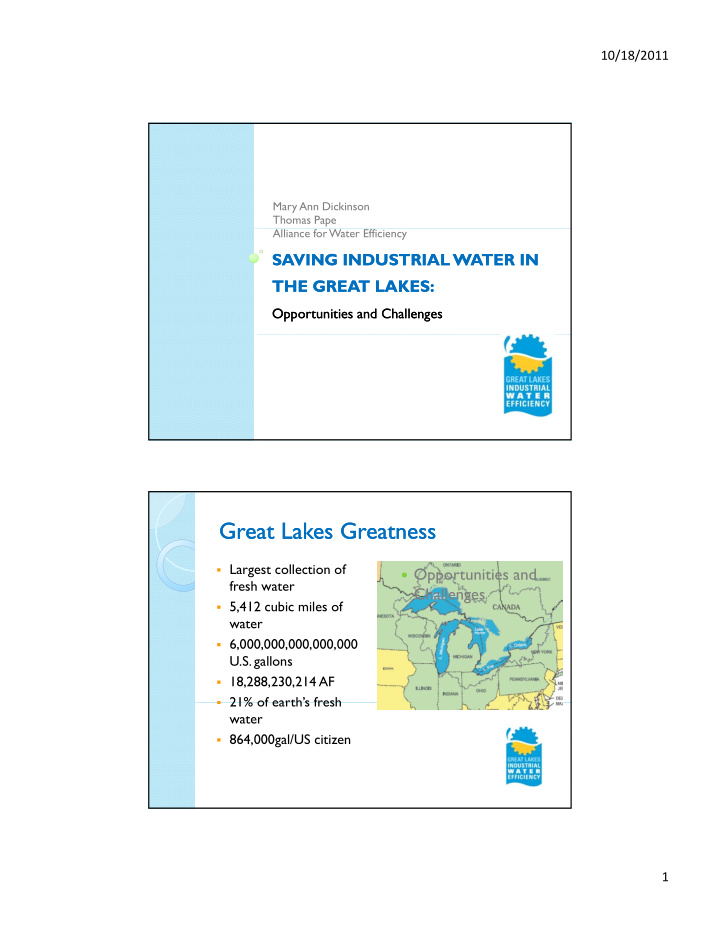



10/18/2011 Mary Ann Dickinson Thomas Pape Alliance for Water Efficiency SAVING INDUSTRIAL WATER IN SAVING INDUSTRIAL WATER IN THE GREAT LAKES: THE GREAT LAKES: Opportunities and Challenges Opportunities and Challenges Great Lakes Greatness Great Lakes Greatness � Largest collection of � Opportunities and fresh water Challenges Challenges � 5,412 cubic miles of water � 6,000,000,000,000,000 U.S. gallons � 18,288,230,214 AF � 21% of earth’s fresh � 21% of earths fresh water � 864,000gal/US citizen 1
10/18/2011 Consumptive Water Use* by Sector Consumptive Water Use* by Sector * Consumptive = Withdrawal - Return Industrial Sector Major Water Users Industrial Sector Major Water Users � Food & beverage products � Ceramics, clay, glass & stone, products � Paper & pulp products � Metal refining and plating � Transportation equipment � Chemicals 2
10/18/2011 Grant Project Grant Project T T eam eam Mary Ann Dickinson – Project Director 1. Thomas Pape – Project Manager 2. Ken Mirvis – Communications 3. William Hoffman – Project Engineer 4. Jeff Edstrom – Environmental Assessment Advisor 5. Townsend Albright – Loan Development Advisor 6. Jeffrey Hughes – Administration 7. Bill Christiansen – Research 8. Molly Garcia – Finance Administration 9. Advisory Committee Advisory Committee Lynn Broaddus, Johnson Foundation at Wingspread 1. Claus Dunkelberg, Milwaukee Water Council 2. Ed Gl tf lt Ed Glatfelter, Alliance for the Great Lakes Alli f th G t L k 3 3. J.B. Hoyt, Whirlpool Corporation 4. Dale Phenicie, Council of Great Lakes Industries 5. Tim Loftus, Chicago Metropolitan Agency for Planning 6. Jeffrey Ripp, Wisconsin Public Service Commission 7. Karen Sands, Milwaukee Metropolitan Sewerage District 8. Adam Rix, Watermark Initiative 9. 10. Shannon Donley, GLPF 3
10/18/2011 Grant Project Time Line Grant Project Time Line Task 1: Research and Discovery (Weeks 1-12) Task 2: Conduct Site Assessments (Weeks 12-40) Task 3: Develop Viable Financing Plan (Weeks 1-20) Task 4: Assess Environmental Benefits (Weeks 40 60) (Weeks 40-60) Task 5: Findings and Recommendations (Weeks 60-72) Final Report: 8/10/12 Grant Project Grant Project Goal Goal � Achieve environmental b fi i h G L k benefits in the Great Lakes ecosystem through demonstration of sustainable water use reduction in the industrial water use sector 4
10/18/2011 Project Project Method Method � Reach out to industries to create awareness of proven technologies and opportunities for efficiency � Offer technical assistance to conduct or verify benefit/cost analyses � Identify barriers to implementing recommended efficiency actions � Create structure for low interest loans to offset implementation costs The Target Market The Target Market � Industries common to Great Lakes area � Industries receiving water from public Industries receiving water from public utility sources in Great Lakes Basin � Industries sustaining or growing in marketplace � Industries or users that are high volume 5
10/18/2011 Assessment Assessment Factors Factors � Participation by target industries industries � Implementation of measures � Water use reductions � Financing feedback � Implementation results Implementation results � Benefit-cost assessment � Environmental assessment Marketing Piece Marketing Piece 6
10/18/2011 Industries Marketed Industries Marketed � Pharmaceutical � Agricultural products processing g p p g � Beverage and food production � Dairy products � Appliance & electronics manufacturing � Plastics molders � Vehicle manufacturing V hi l f i � Metal platers � Others? Industries Industries Visited on Site Visited on Site MI Bell’s Brewery WI Diedrich Tanning g OH Whirlpool OH Equastar WI Reliable Plating Works WI Harley-Davidson NY LaFarge Concrete WI Law Tanning WI Pho-Tronics WI Mickey’s Linen Service 7
10/18/2011 Project Sites Chosen Project Sites Chosen � Tanning Industry � Appliance Manufacturing � Appliance Manufacturing � Beverage Production � Metal Plating � Chemical Compounding Opportunities Opportunities � Many water intensive industries � Attracted to plentiful water � Attracted to plentiful water � Little water efficiency assistance � Eager to be cost competitive � Desire to preserve the resource � Low prime rate Low prime rate � The new greening of the industries 8
10/18/2011 Challenges Challenges � Relocation of industry: Should they stay or go? � Plentiful rainfall: 50+ inches/year � Plentiful water: low water prices � Plentiful infrastructure: high overhead costs � Dwindling customer base: little utility support � Greenwashing: uncertain level of commitment � Very short payback required: cherry picking Very short payback required: cherry picking � Regulations & rates: savings negated? Reasons for Optimism Reasons for Optimism � There is HUGE HUGE savings potential. � Most measures are simple and fast. � Sustainability Chiefs are enthusiastic to carry the ball. � World competition requires lowering operating costs. � Evolving use of Great Lakes requires sustainable consumption and better water sustainable consumption and better water quality. � Plentiful rainfall to harvest. 9
10/18/2011 10
Recommend
More recommend